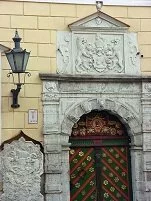Architecture of Estonia
Most traditional Estonian architecture is wooden so there is little that remains today outside the larger cities, most notably Tallinn, although there are numerous country houses and manors that have survived in various locations.

Tallinn
Tallinn contains most of the country's architectural gems as it first rose to prominence in the 1200s and shortly after became a leader in the Baltic Sea trade as a member of the Hanseatic League, leading to a building boom. For the most part, Tallinn is a Gothic styled city. St. Olaf's Church (1200s) is a great example of Estonia's Gothic architecture and was the tallest building in the world in the 1500 and 1600s (after adding a taller steeple and spire to the original building). Even today, much of Tallinn's old town remains in the Gothic style, although numerous additions and variations have been amended since.
Estonia is also dotted with numerous castles and manors, most of which were either Danish or Teutonic (German) in origin and style. Among the best preserved are the Toompea Castle (primarily constructed in the 1200s) and the Hermann Castle (much of what is seen today is from the 1300s and later).